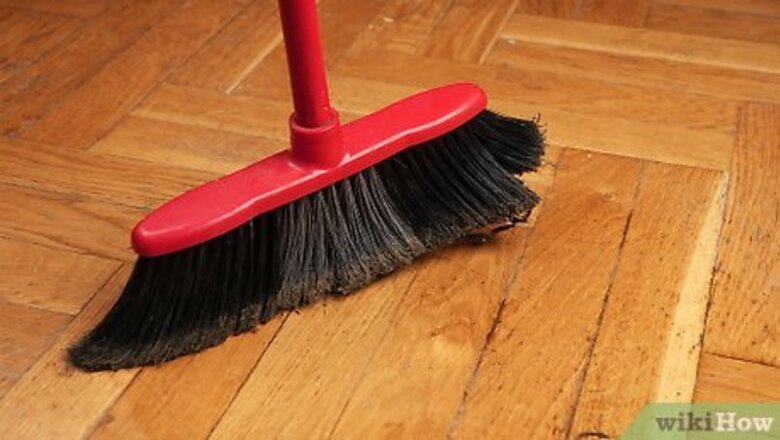
views
Cleaning Wood Floors
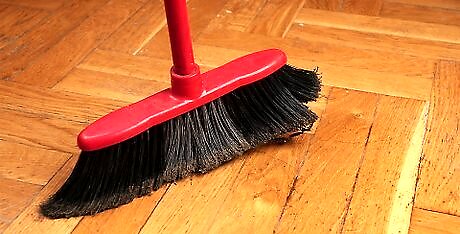
Clean excess dust or dirt from the wood floor. The first step is to remove any debris from your floors. Grab a broom and sweep your floor clean. You may also want to mop it with warm water and a little bit of a water-based cleaner. Remove loose surface dirt and dust with a clean, soft cotton cloth in specific areas, like under furniture. Suck up dust or surface dirt with a vacuum cleaner, using the hose and soft brush attachments. Cleaners that have a neutral PH balance won’t disturb the finish of your floor. Cleaners like detergents can remove dust and dirt, but have a higher PH balance. Only use these on older floors.
Damp-mop the floor. To get a real good cleaning in that lifts the dirt and grime you can’t remove by sweeping you can damp-mop your floors. Use a wood cleaning product that is designed for your hardwood floor. Dilute the product in water according to the instructions on the bottle. Then, dip a sponge or mop into your solution and wring it out until it is close to dry. Scrub your floor. You want your sponge or mop to be damp and not wet so you don’t leave any standing water on your floor. Floor cleaners like Bona Hardwood Floor Cleaner are specifically made to be safe on hardwood floors, and will even get rid of scuff marks and hardened spills. EXPERT TIP Susan Stocker Susan Stocker Cleaning Guru Susan Stocker runs and owns Susan’s Green Cleaning, the #1 Green Cleaning Company in Seattle. She is well known in the region for outstanding customer service protocols — winning the 2017 Better Business Torch Award for Ethics & Integrity —and her energetic support of green cleaning practices. Susan Stocker Susan Stocker Cleaning Guru Try cleaning with deionized water. Deionized water has had all its ions removed and has no charge. The water is chemical-free, won't damage any finishes, and dries quickly. Water is an underrated and fantastic cleaning agent. The suds and fragrances in many commercial cleaners are only there for effect.

Remove marks. Before you go and start scrubbing at those scratches, marks, and stains, determine which kind of hardwood floor you have. If your stains are surface level, you probably have a hard urethane finish. However, if the stain goes deeper into the wood, you may have a soft oiled finish. For hard finishes, only use a soft, clean cloth to wipe. Harder brushes, harsh chemicals with a higher PH balance, or steel wool can ruin your coating. For soft finishes, you can use No. 000 steel wool and wood floor wax. If the area doesn’t lighten up, apply vinegar to warm water and soak the area for about an hour. Then rinse with a clean damp cloth. As a general rule for soft finishes, use steel wool and floor wax for tougher marks, and a light cloth with dishwashing detergent and water for lighter, or oil-based stains.
Cleaning Wood Furniture
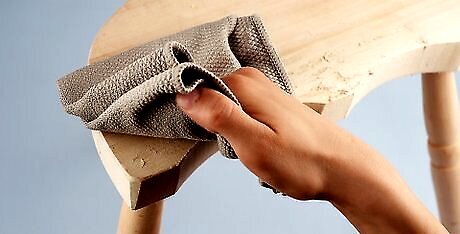
Dust your furniture. Use a soft, lint-free cloth to go over all of your furniture before you wipe it down. This will lift any dust and other small particles that might otherwise get ingrained into your furniture when washing. Feather dusters aren’t as effective for furniture because a feather duster won’t lift any particles. Some feather dusters also have sharp quills which could scratch your furniture.
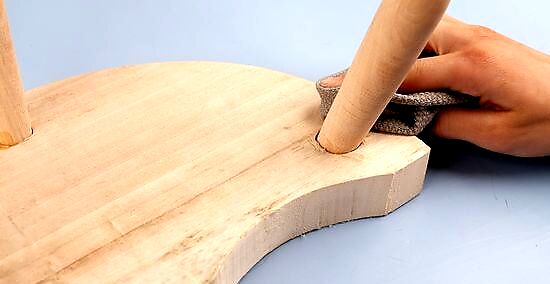
Start on a small surface. Unless you know for sure what kind of finish your furniture is, paint, stain, or another treatment, it’s best to start with the least harmful cleaning products on a small area. Grab a cotton ball or soft cloth. Moisten your cotton ball or cloth with warm water and add a drop of dish soap or dishwashing detergent. Start wiping an inconspicuous area of your wooden furniture like the inside of a leg. Right now, you want to test to see if the detergent is going to be harmful to your wood furniture. Let the treated area sit for a minute or so and look for any discoloration. If you don’t notice any unwanted change, your solution is safe. If you do notice a change, then continue with only warm water and a damp cloth.
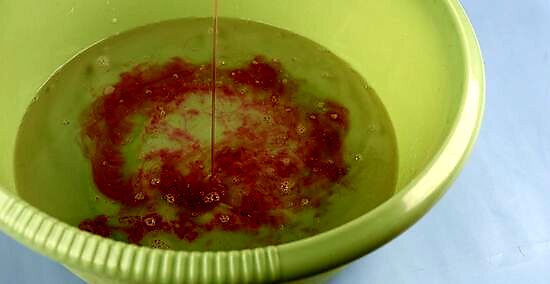
Mix water and dish soap. If you didn’t notice a change when you tested your furniture. You can mix water and dish soap in a bucket. Mix 1 gallon (3.8 L) of warm water and 1/2 cup of liquid dish detergent. You want to add enough soap so your water is soapy. Start wiping down your furniture with a damp cloth that you dipped in your solution. Be careful not to soak the wood. Keep your cloth or sponge damp but not soaking wet. Too much water will ruin the wood. You can also use mineral oil to clean your wood in addition to or as a substitution to detergent.
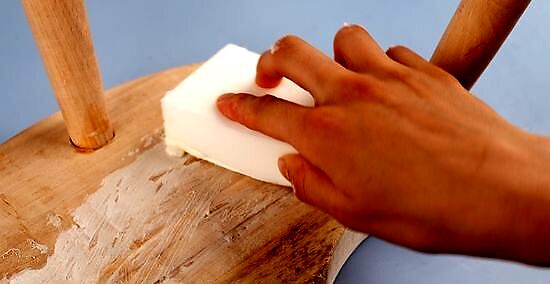
Wax or polish your wood. After you’ve thoroughly wiped down your wood, protect it by applying a wax or finish. You can find a variety of wood-specific sprays and polishes at any home goods store or grocery store. Look for sprays that contain silicone oil for protection. For waxing, use only a soft cotton cloth or wax brush. Apply the wax a little at a time and rub it into the wood in a circular motion. Once the wax begins to look dry or hazed over, grab a new cotton cloth or wax brush and buff the wax going in small circles over the waxed area. Different waxes will require you to wait different amounts of time before buffing. Read the directions on your wax for best results. Test a rub-on oil, spray, or wax on a small area of wood to ensure it does not cause damage to the wood's finish.
Cleaning Other Wood Surfaces
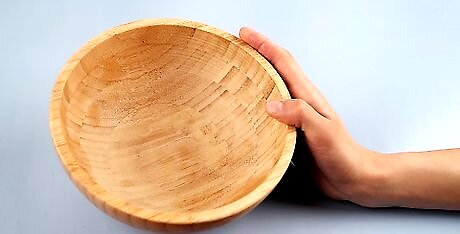
Use non-harmful homemade cleaners. If you have other wood items or surfaces, especially wooden bowls, you can clean these items with safe ingredients that are safe to digest. You make an effective and harmless wood cleaner with a lemon, olive oil, and water.
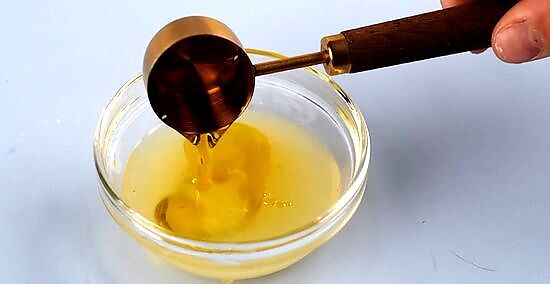
Mix your ingredients. Take one lemon and cut it in half, then strain the juice in a container. It’s best to strain the pulp and seeds out for your solution. Add a tablespoon of olive oil and water each. You can stir your mixture together, but it’s best to mix your ingredients in a container with a lid and shake it up to diffuse the lemon juice and olive oil into the water. You can also use distilled white vinegar if you don’t have a lemon. If you’re mixing olive oil and vinegar, add one tablespoon of vinegar for every three tablespoons of olive oil.
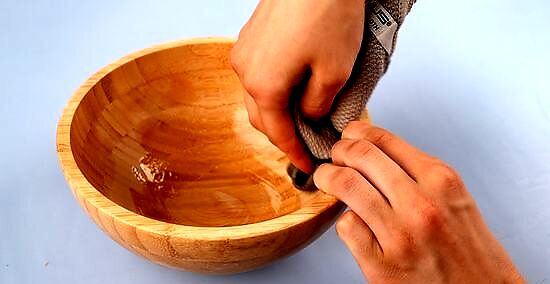
Wipe your surfaces. With a clean cotton cloth, dip it into your solution and ring the cloth out so it’s moist, not wet. Simply wipe down your surface with your homemade solution. Test your solution on a small area first just to make sure it reacts well with your wood. This homemade product is not only safe for you, but it won’t leave a film or streaks behind.



















Comments
0 comment